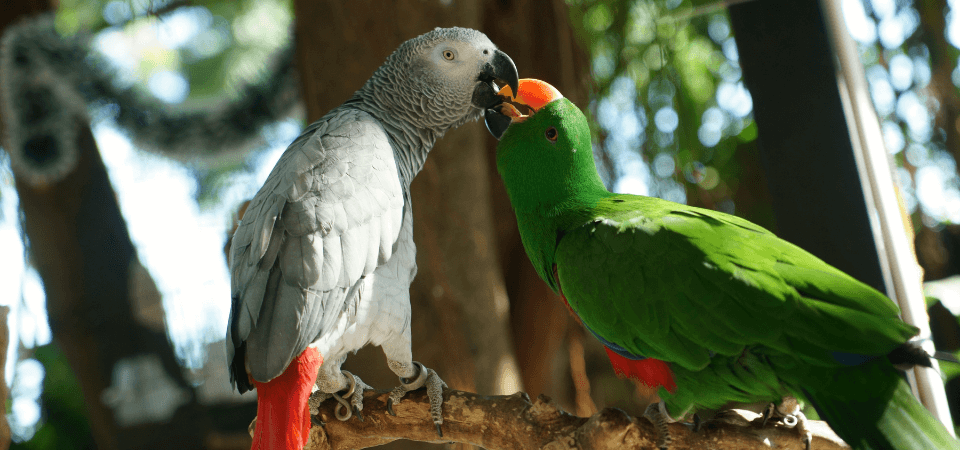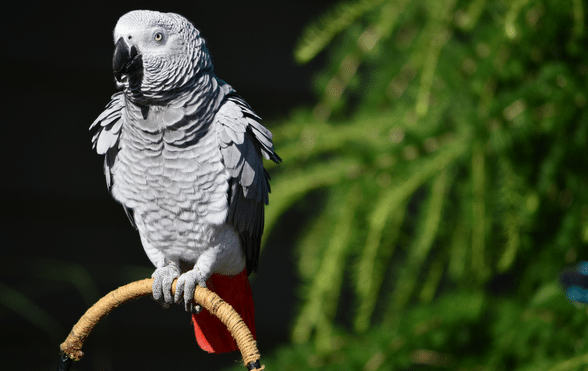Vet expert Dr. Sophie Bell discusses the issue of fatty liver disease (Hepatic Lipidosis). She explores causes, the most common symptoms, the main preventative methods, how it is diagnosed and then treated through diet and medicine.
Is your parrot insured? Get a quote for up to £5,000 of vet fee cover, death and theft cover | We’ve been insuring exotic pets since 1996 | Check out our customer reviews on Feefo.
How common is fatty liver disease?
Fatty liver disease is a commonly reported condition in birds. Although for some birds there will be a hereditary element, the most significant cause is diet and lifestyle, leading to obesity.
With the correct management by their caregivers, it can be an easily avoided condition.

Parrots and Fatty Liver Disease
How to tell if your bird is obese
Monitoring your parrot’s weight is a vital role as a pet owner. An obese bird, one who is often fed too much, especially a high fat diet, can be prone to several medical conditions. The same can be said for a bird who is underweight.
It is difficult to assess weight by visualisation alone as the feathers covering the body make it hard to see muscle mass and fat deposits. Although you may notice weight loss or gain when handling your bird, by this stage it could be too late and your bird may well have lost or gained dangerous amounts of weight, putting them at risk of health problems.
Weight changes may alter your bird’s behaviour, common examples being lethargy and fluffing up of feathers. Often the weight change at that point will be dangerous to your bird’s health.
Regularly weighing your bird and keeping a record is a great way to monitor for any changes. This means you may detect a problem quicker, consult your vet promptly, and make necessary dietary and/or other lifestyle changes.
Fatty liver caused by obesity
We now know that obese birds are prone to a condition known as fatty liver disease or hepatic lipidosis.
Fatty liver disease is where fat cells accumulate in the liver and take over healthy cells. This ultimately leads to the destruction of healthy cells with end-stage liver disease as a result. This condition is serious and if left untreated can be fatal.
The liver is an extremely important organ that plays a vital role in your birds’ metabolism. Any disease that affects it will have a profound effect on your bird’s health.
Symptoms of Fatty Liver disease
- Green urates/droppings
- Diarrhoea
- Lethargy and depression
- Inability to fly
- Anorexia
- Breathing difficulties due to the enlarged liver taking up excess space
- Swelling of the abdomen
- Itchy skin
- Obesity
- Discoloured and poor-quality feathers
- Seizures/tremors
- Claws and/or beaks can become overgrown
- Loss of balance
- Blood clotting disturbances – may see black spots on the toenails and/or beak
- Jaundice – yellowing of the skin
Fatty liver caused by obesity
Some causes of fatty liver disease are hereditary but most commonly nutrition and lifestyle are a major risk of developing this condition. Females appear to be at a higher risk compared with males with a hormonal element playing a role.
How to prevent fatty liver disease
It is important to feed a balanced diet to avoid excess weight gain and nutritional deficiency. Birds fed a diet consisting mainly of seed are at an increased risk of developing fatty liver disease.
Seed based diets contain a lot of fat and therefore should never be fed in high quantities. Seeds also lack vitamin A which is a vital part of your bird’s nutritional requirements.
In summary parrots require a varied diet like they would have in the wild with a mix of fresh fruit, vegetables, and flowers.
Check the flowers you choose are not poisonous to your parrot and offer fruit in moderation due to its high sugar content.
Feeding high quality pellets are a good and easy source of providing many of the vitamins and minerals required alongside fresh foods. Add a little seed if you wish but remember seed mixes do not offer a complete diet.
Nuts can also be offered but be sure to pick ones that are safe for parrots to eat. Remember nuts are also high in fat and just like seed should not be offered frequently and/or in large amounts. Regulation will help maintain good body condition and minimise the risk of developing fatty liver disease.
Peanuts can contain mycotoxins especially if they are past their best. Mycotoxins are products of fungus such as mould and can cause further damage to your bird’s liver. It may be best to avoid them, unless you are absolutely certain they are mould free. As with all food offered, make sure it is fresh and remove any old food that has been dropped to prevent ingestion.
Our article What to feed parrots is a useful resource for developing a well-balanced diet
Metabolic stimulation is vital
In attempt to prevent fatty liver syndrome, environmental enrichment and regular exercise both play an important role.
Choosing an aviary or bird room where your bird can get out for daily exercise is a great way of preventing boredom and expending some energy.
Or your bird can just spend time with you outside its cage. Birds love to be involved in what you’re doing. Remember to ensure windows and doors are secure if you do this.
Simple ideas such as providing cardboard for them to shred, using parrot safe toys and games, and scattering foraging food, rather than using a bowl will help. You can learn more about home made toys in Exotic Direct’s article.
Cage size is important, and you should provide as large a cage as possible, so your bird can move around and spread its wings. Multiple perches will also help this.
Finally, birds who are bored will often overeat, this can lead to huge weight-gain and thus increase the risk of fatty liver disease. You should aim to feed around two to three times a day, with food bowls removed 30 minutes after eating. This advice is offered by parrot expert Dorothy Schwarz in her article: What to feed an African grey parrot.
Metabolic disorders increase the risk of developing fatty liver disease
If your bird is suffering with a condition such as diabetes mellitus, which is thankfully uncommon in pet birds, this can increase their risk of developing fatty liver disease.
Overweight birds have an increased chance of developing diabetes mellitus as well as fatty liver disease which is why weight management is so important.
How is fatty liver diagnosed?
You will need to take your bird to an avian vet where blood tests will be performed along with a health check and a test on their history regarding their lifestyle, diet and exercise regime.
The blood tests will show fat in the blood known as lipemia, signs of damage to the liver and low red blood cells (anaemia). If the condition is diagnosed early, treatment can be successful, and your bird can make a full recovery.
One vital change once your bird is home will be changes to the diet, but this can be tough as birds are often reluctant to try to new foods. Any diet changes must be done gradually – your vet will be able to advise you on how best to do this and which foods to pick.
What treatment is undertaken for fatty liver?
For fatty liver there are some instances in which treatment is required. Some birds require supportive treatment, as they need to be tube fed if they stop eating, and also given fluid therapy.
Lactulose is sometimes used to reduce intestinal absorption of the food however this is a laxative so can also cause diarrhoea.
Sometimes vitamin E and B complexes are given to aide recovery. But the major part still goes back to dietary change – decreased fat, increased protein, and some carbohydrates to give energy due to low fat content.
This diet is gradually adjusted by your vet.
Is your parrot insured? Get a quote for up to £5,000 of vet fee cover, death and theft cover | We’ve been insuring exotic pets since 1996 | Check out our customer reviews on Feefo.

